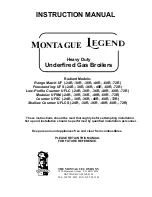
Remeha
Quinta 45/65
36
NOTE:
this system may not be used in areas with adverse wind conditions (i.e. in
some coastal regions).
NOTE:
If the design parameters are outside the values shown in the above table or
there is any doubt over the flue system, please contact our technical department for
calculation to be undertaken
.
7.3.7 Modular
installations
For flue gas-side and air-side connections for multiple boilers in cascade configuration,
refer to Broag for advice.
7.4 Hydraulic installation
7.4.1 Condensate
discharge
Discharge the condensate via a tundish, directly into a drain. Only use synthetic mate-
rial for the connecting piping, because of the acidity (pH 2 - 5) and allow a min. of 30
mm per M to ensure a good flow rate. Fill the siphon with water before firing the boiler.
It is not advisable to discharge into an outside gutter, because of the risk of freezing.
7.4.2 Water
treatment
The system should be filled with mains cold water (for the UK this will usually have a
pH of between 7 and 8).
Pressurised installations with a boiler/system content ratio of 1:10 or less should not
require water treatment, provided that the following conditions apply:
- The system is flushed thoroughly to remove all fluxes and debris and filled comple-
tely once.
- Make up water is limited to 5% per annum.
- The hardness of the water does not exceed 360 ppm (20°D).
All scale deposits will reduce the efficiency of the boiler and should be prevented.
However provided the above is complied with any scale produced will not be too detri-
mental to the boiler efficiency and will not reduce the anticipated life expectancy of the
boiler.
NOTE
: Scale deposits in excess of 5 mm will reduce boiler efficiency and increase the
risk of premature casting failure.
As most systems contain a variety of metals, it is considered good practice to provide
some form of water treatment (especially in open vented systems) in order to prevent
or reduce the following.
- Metallic corrosion
- Formation of scale and sludge
- Microbiological contamination
















































